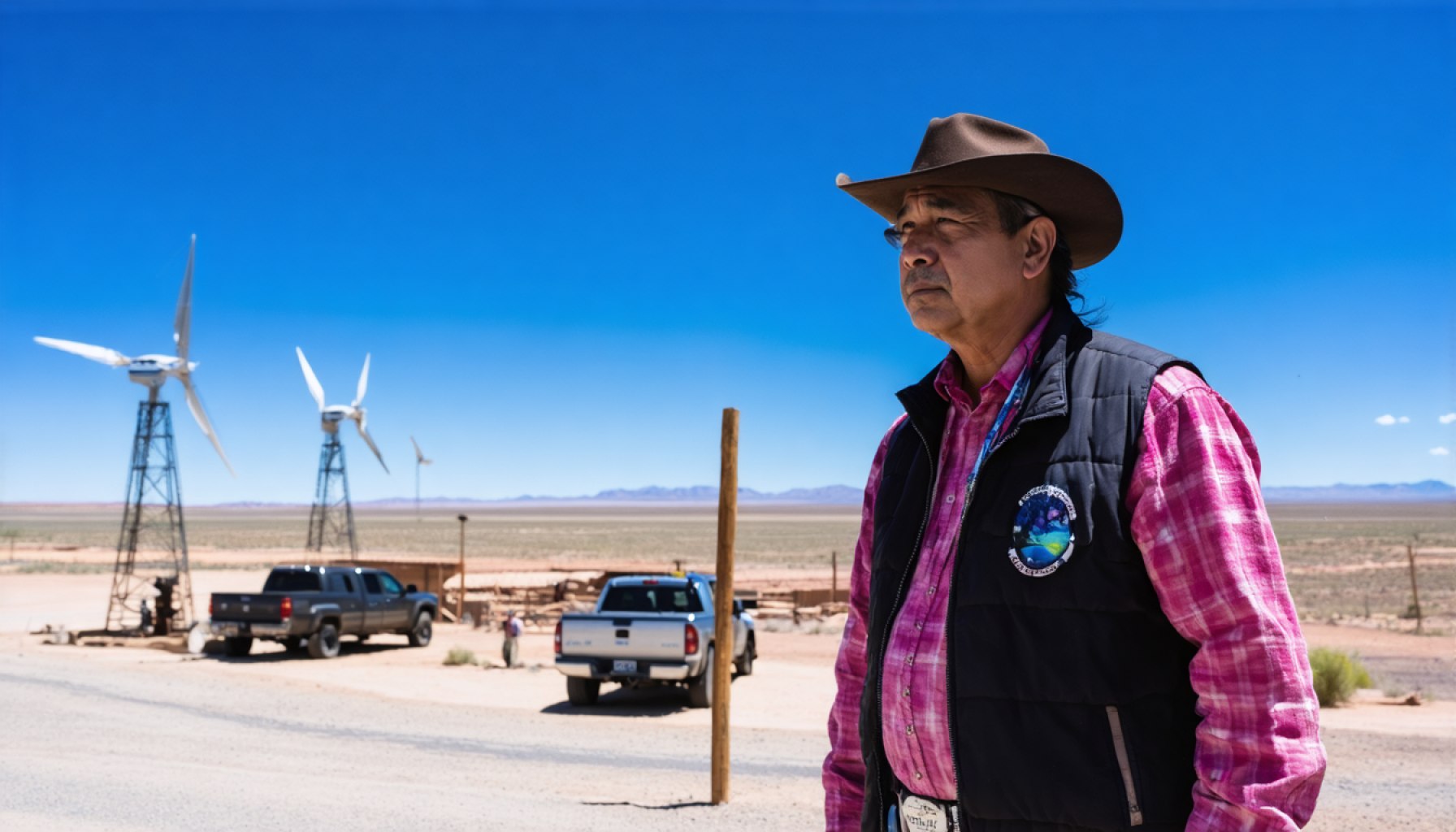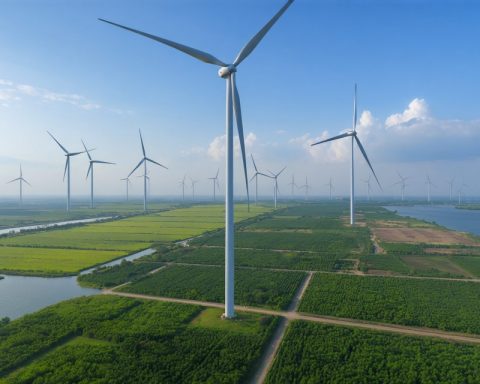- The Four Corners region, rich in natural resources, faces a paradox: expansive energy exports juxtaposed with local energy poverty on the Navajo Nation.
- Brett Isaac’s company, Navajo Power, is replacing diesel generators with solar panels, empowering over 320 homes since 2023.
- Projects like Navajo Power emphasize energy sovereignty and are a symbol of Indigenous innovation and resilience.
- The Biden Administration’s Greenhouse Gas Reduction Fund (GGRF) promises support for clean energy projects but is currently stalled by bureaucratic hurdles.
- This pause significantly impacts visionary projects vital for disadvantaged communities, including health and community centers.
- Antony Stately highlights stalled plans for a zero emissions clinic in Minneapolis as part of the broader struggle for sustainable development in Indigenous communities.
- The overarching narrative addresses the need for equitable support and the moral responsibility to ensure clean energy access for Indigenous peoples.
The stark beauty of the Four Corners region, where the arid deserts of America’s Southwest cradle the intersection of Arizona, Utah, Colorado, and New Mexico, hides a poignant paradox. High above the ochre plateaus and mesas, massive power lines carry electricity to the booming cities beyond, harnessed from coal mined beneath tribal lands. Yet, for many residents of the Navajo Nation, the luxury of electrical power remains a distant reality, their homes still reliant on the hum of costly, polluting generators.
Brett Isaac, a trailblazer from the Navajo Nation, envisions a different future powered by the blazing sun that arches across these skies. Navajo Power, the company founded by Isaac, seeks to replace the drone of diesel with the clean hum of solar power. Since 2023, over 320 homes have been brimmed with solar panels, a testament to both innovation and resilience. These aren’t just any panels; marked with the proud insignia of “Made in America,” they symbolize a promise—a tangible step towards energy sovereignty in a land long overlooked.
However, the tribal venture finds itself entangled in the bureaucratic freeze of the Biden Administration’s Greenhouse Gas Reduction Fund (GGRF), a lifeline intended to galvanize clean energy projects in underserved areas. The vibrant tapestry of visionary projects, from health clinics to community centers, lies suspended in a haze of administrative red tape. This halt is a stark reminder of the broader systemic challenges faced by Indigenous communities, echoing centuries-old narratives of broken promises.
Isaac and likeminded leaders stand at a crossroads, their efforts caught in the crossfire of political discord. The planned reach of the GGRF, a revolutionary endowment aimed at steering investment towards disadvantaged sectors, stands curtailed, casting a shadow over the ambition to electrify thousands more homes on the reservation.
Amidst this tableau, Antony Stately of the Native American Community Clinic in Minneapolis underscores the enduring struggle. Stately’s envisioned clinic expansion—with the potential for zero emissions through innovative geothermal heating—now teeters on the edge of conventionality, a sacrifice at the altar of paused funding. For communities entrenched in cycles of poverty and poor health outcomes, such sustainable developments could have been a beacon of transformation.
This narrative is not just about funds frozen or jobs undone; it is the story of resilience and defiance, a clarion call for equitable support and opportunity. In the face of thwarted potential and broken promises, Isaac’s work exemplifies the tenacity to continue—a testament to Indigenous innovation and stewardship. As courts weigh decisions and administrative tides turn, the broader American society must confront the question of commitment and accountability.
Can a nation truly prosper if its progress leaves behind its own first peoples? The sun continues to blaze over the Four Corners, relentless and impartial, a reminder that the potential for energy independence and sustainable development is vast and waiting. The challenge now is not only technical but moral: to honor agreements and ensure that clean, renewable energy reaches every doorstep under its radiant gaze.
Revolutionizing Energy in the Four Corners: The Quest for Solar Sovereignty
Understanding the Four Corners Paradox
The Four Corners region, a unique intersection where Arizona, Utah, Colorado, and New Mexico meet, faces a paradox. Despite being rich in natural resources and a potential hub for renewable energy, many residents of the Navajo Nation still lack access to reliable electricity. This situation underscores broader systemic issues that continue to affect Indigenous communities in the United States.
The Role of Navajo Power in Promoting Solar Energy
Brett Isaac, a trailblazer from the Navajo Nation, founded Navajo Power with a vision to leverage the abundant sunlight in the region. The initiative, which has already equipped over 320 homes with solar panels since 2023, is a pioneering effort to achieve energy sovereignty. These solar panels are not just functional; they are a source of pride, bearing the “Made in America” insignia. The push towards solar energy is a crucial step in reducing reliance on costly, polluting diesel generators.
Bureaucratic Challenges Impeding Progress
A significant obstacle for projects like Navajo Power is the administrative pause on the Biden Administration’s Greenhouse Gas Reduction Fund (GGRF). Intended to support clean energy projects in underserved areas, the GGRF’s suspension has left many initiatives, such as health clinics using zero-emission geothermal heating, in a state of limbo. This administrative freeze highlights the broader theme of broken promises and systemic neglect faced by Indigenous communities.
Insights and Market Trends in Renewable Energy
1. Solar Panel Innovations: There is a growing trend towards more efficient and cost-effective solar panels. According to a report by the International Energy Agency, solar energy capacity has been expanding at over 20% annually, driven by technological advancements.
2. Investment in Renewable Energy: Despite bureaucratic hurdles, investments in clean energy, especially solar power, are projected to increase significantly. The global solar energy market is expected to grow from $52.5 billion in 2018 to $223.3 billion by 2026, at a CAGR of 20.5% during the forecast period.
3. Policy and Funding Opportunities: Policymakers are increasingly aware of the need to streamline funding processes for renewable energy. Future policies might aim at reducing red tape and increasing accessibility to available funding for Indigenous and underserved communities.
Real-World Use Cases for Solar Energy
– Residential and Community Electrification: Deploying solar panels ensures a reliable and sustainable power supply, reducing dependence on non-renewable energy sources.
– Economic Empowerment: Initiatives like Navajo Power create jobs, enhance technical skills, and stimulate economic activities within the community.
– Environmental Sustainability: Transitioning to solar energy significantly reduces carbon emissions, contributing to a cleaner environment.
Overcoming Challenges: Recommendations
– Advocacy for Policy Change: Indigenous leaders and renewable energy advocates should continue to push for policy reforms that facilitate access to funding.
– Community Engagement: Educational initiatives can help communities understand the benefits of solar energy, creating grassroots support for renewable projects.
– Partnerships and Collaborations: Forming alliances with environmental organizations and tech companies can bring in expertise and resources for project expansion.
Conclusion and Quick Tips
To truly capitalize on the potential of solar energy in the Four Corners, several immediate actions can be beneficial:
– Explore Local Subsidies: Residents and businesses should investigate whether local or state subsidies are available for solar energy installations.
– Utilize Energy Efficiency Measures: Complement solar installations with devices that monitor and manage energy use to maximize efficiency.
– Leverage Online Resources: Use platforms like the Department of Energy to learn more about solar technology and funding opportunities.
In conclusion, the Four Corners region’s quest for solar sovereignty, championed by initiatives like Navajo Power, represents a beacon of hope and resilience. Overcoming bureaucratic and systemic barriers requires continued advocacy, innovation, and commitment to equitable energy solutions. The sun’s relentless energy remains untapped potential, waiting to transform lives and communities across the Southwest.













